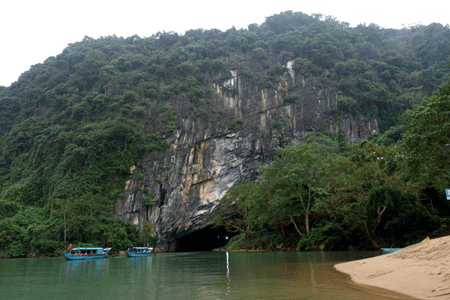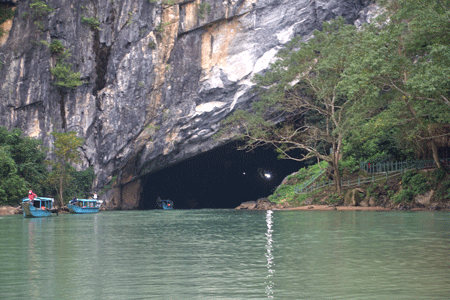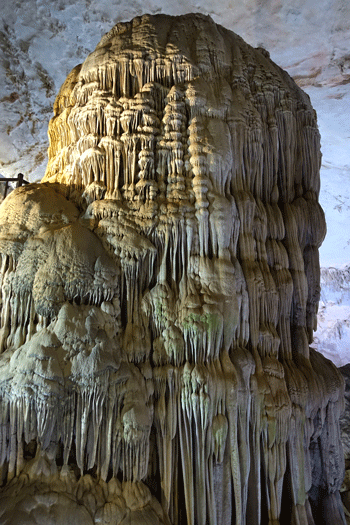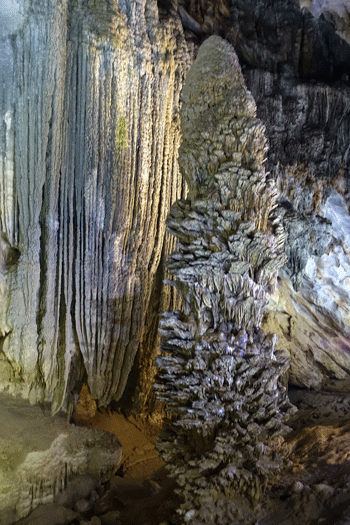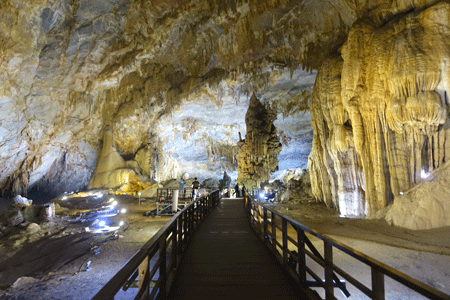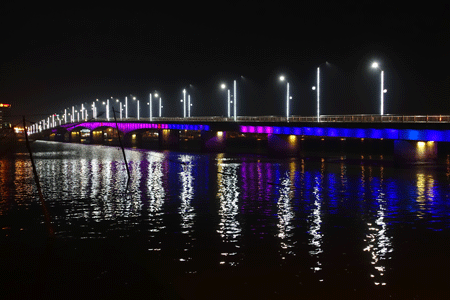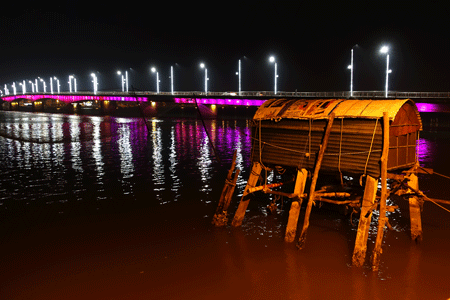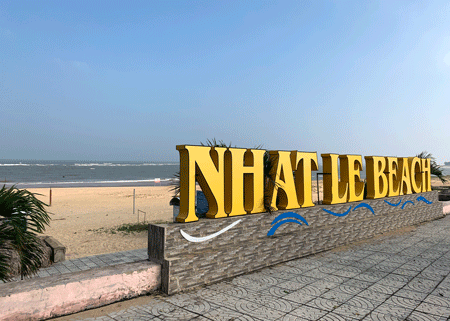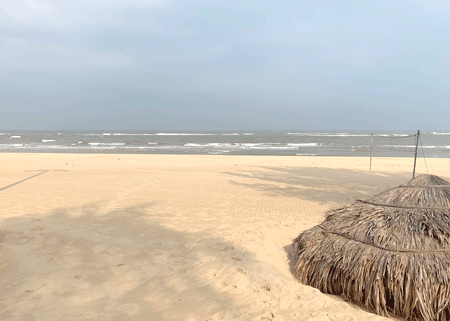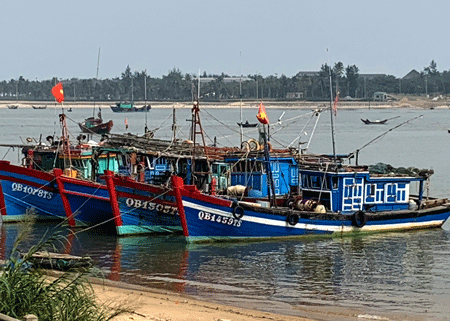
Posted December 17, 2019
Welcome to Vietnam
Anh carried a Canon EOS 5D Mark IV DSLR camera. It’s a really nice, expensive camera. A beautiful thing, really.
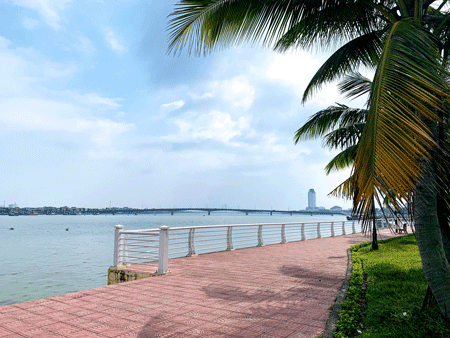
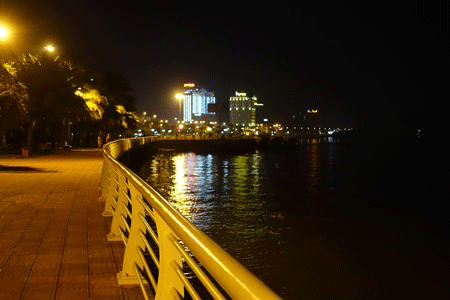
We were walking along the waterfront in Dong Hoi after dinner one night, not far from our hotel, the Nam Long. Anh seemed eager to say hello, and we were happy to oblige.
Anh had just returned to Dong Hoi, his hometown. He’d been at university in Germany, studying Photography, which explains the nice camera. He was walking with a young woman, maybe a sister.
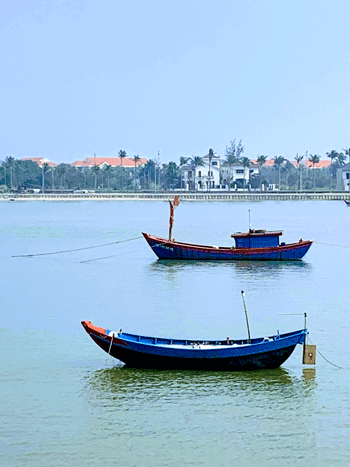
Anh was surprised to learn we were from the United States. He said he doesn’t see many Americans visiting Dong Hoi.
We’ve had the same experience as Anh. The majority of foreigners we encounter are from Netherlands, France, and Germany. We rarely come across Americans.
We shook hands and parted ways. As we walked away, Anh said warmly, “Welcome to Vietnam”.
The American War
It’s our experience that the Vietnamese people are friendly and welcoming. At times I’ve felt uncomfortable as we’ve traveled in Vietnam when we’ve encountered evidence of the atrocities of the American War (what Americans call the Vietnam War).
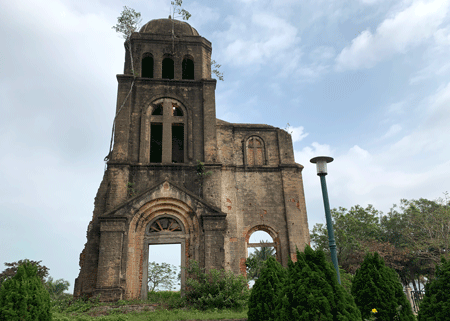
The city of Dong Hoi, where we stayed for three nights, was destroyed during the war. Almost everything in the city was annihilated. Only the remnants of a Catholic Church and one water tower stood after the constant bombings. The government plaque in front of what remains of the church states that the church’s destruction is “evidence of war crimes by the American aggressors”.
Propaganda and Facts
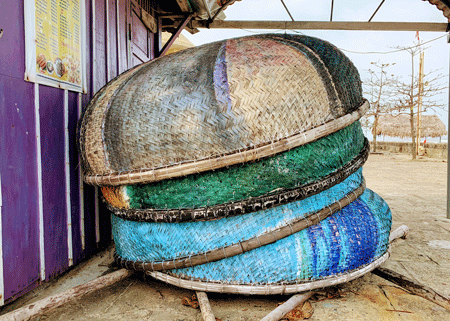
There’s a definite mix of government propaganda, as well as facts, in the presentations of the war sites and the museums we’ve visited. But considering 70% of Vietnamese are under the age of 35 and have only been exposed to one side, it’s really quite amazing that they seem to hold no animosity towards Americans.
Even on our day trip to two local caves, the American War came up a couple of times.
Phong Nha – Ke Bang National Park
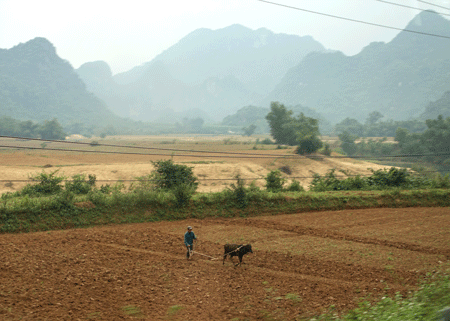
taken from the bus heading to the National Park
We had arranged for a one day excursion to see the Paradise and Phong Nha caves, two of the largest caves in the world, located in the Phong Nha – Ke Bang National Park, about an hour from Dong Hoi.
Our Tour Group
We were the only Americans, out of the group of eleven, traveling on the “Tour the Caves” tour that day.
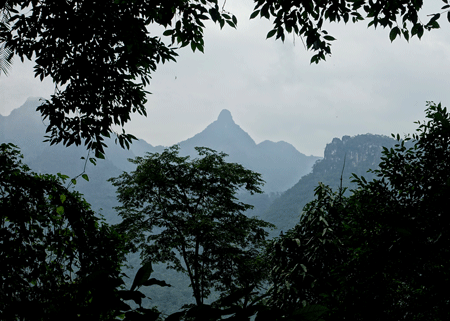
There were three Japanese, a solo French woman in her 20’s, a solo 20 something Japanese woman, a German man traveling with a French woman, a solo German woman in her late 50’s (who had had terrible food poisoning the prior day – ugh), and another solo 50 something woman from Holland, who was also staying at our same hotel.
During a rest break from hiking up to our first cave, Kate (our guide) told Steve and I that she had studied at a University in southern Vietnam to become an English teacher. When she returned to her town near Dong Hoi, happy and ready to begin work as an English teacher, the officials demanded a large bribe before they would hire her. She couldn’t afford the bribe, and ended up working as a guide, which she loves and (she said) pays better.
Phong Nha Cave
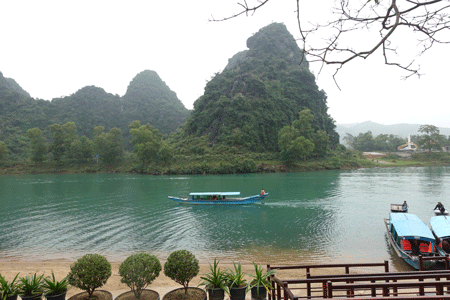
Phong Nha cave is a wet cave, meaning a river flows through it. To reach the cave we took a boat upriver about thirty minutes.
During the height of the rainy season the water level gets so high that boats cannot pass through the cave.
Thankfully it hadn’t rained much the past week, and we were able to visit the cave, even though the rainy season doesn’t end until the end of the month. Just a couple of weeks earlier and we wouldn’t have been able to enter Phong Nha cave.
Entrance to Phong Nha Cave (left: far shot, right: close up)

A few hundred feet inside the cave was a beautiful, fine sand beach leading into a huge dry passage. At this point in the cave the ceiling was hundreds of feet high and wide, with an expansive feel.
The boat pulled up onto the beach, where we got off. The sand was powdery and white, and created a steep incline into the dry passage above.
The Underground Hospital

The beach was pristine and peaceful, but this very same beach, and the corresponding dry compartment, were an underground hospital during the American War. It was the safest place to house the wounded.
We walked up the beach and through the passage, admiring the majesty and incredible beauty, while also picturing the horrors of wounded soldiers who laid here, hoping to recover.
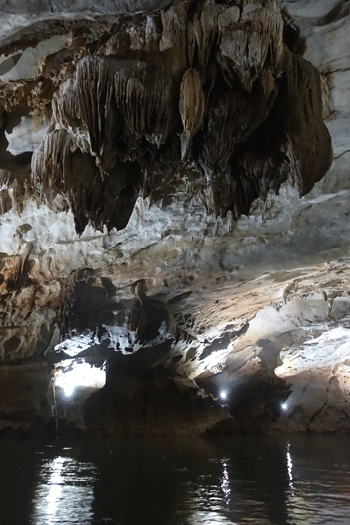
Our tour guide, Kate, recounted the war hospital story matter of factly, without any apparent judgement.
The American War is just one chapter in a very long and sordid history of occupation and foreign wars in Vietnam.
Kate also told us that the area’s children are still affected by agent orange, the chemical defoliant used by the Americans during the war.
Ho Chi Minh Trail
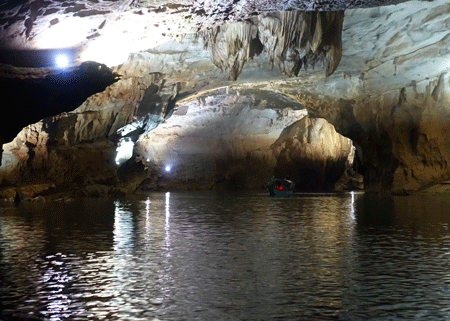
This same cave was a part of the Ho Chi Minh trail, used during the war to transport troops and supplies between north and south Vietnam. We entered the cave in Vietnam, but if you follow the river upstream for about 15 miles, you’d pop out in Laos, west of central Vietnam.
My Cave’s Bigger than Your Cave
According to our guide, Kate, Phong Nha – Ke Bang National Park in Vietnam contains two of the three largest caves in the world. The number two cave is in Malaysia. Back at the hotel we googled this, and it turns out there are lots of ways to measure and/or rank cave size. So anyway…
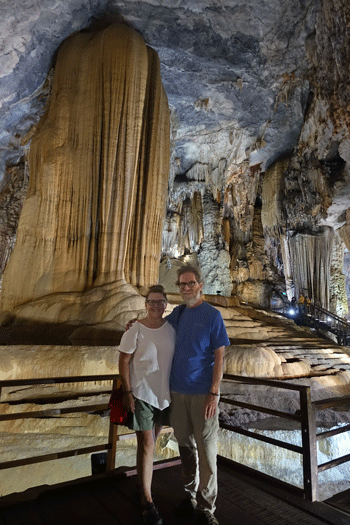
For the time being, everyone considers Hang Son Doong, here in Vietnam’s Phong Nha-Ke Bang National Park, to be the largest cave in the world. It was discovered only a few years ago in 2013. Son Doong currently stretches across 38.5 million cubic meters (about 1.35 billion cubic feet) — so big, it even has its own jungle inside. To reach Hang Son Doong requires a strenuous four day hike with camping and trekking inside the cave.
Excursions to the cave are tightly regulated and only a few hundred people a year are allowed in. You must book up to a year in advance, be very fit, and have a generous travel budget. It costs three thousand dollars per person for the four day excursion.
Kate laughed when she told us there’s a cave competition among the Southeast Asian countries. Even though Vietnam has the #1 and #3 largest caves in the world, they are always looking for more caves to make sure they stay on top.
Paradise Cave
The other cave we visited was Paradise Cave, perhaps the third largest cave in the world (according to Kate). It was discovered by a local man in 2005, and opened to the public in 2010.
The Vietnamese government handsomely rewarded the man, who now lives a very different life than he did prior to his discovery.
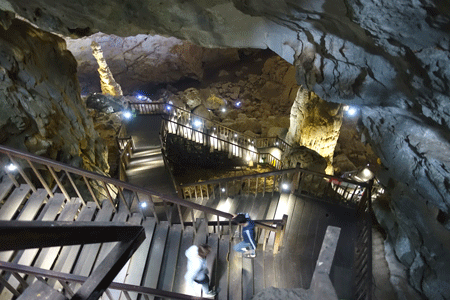
We entered the cave and went down, down, down maybe a hundred stairs, descending into the depths of the cave.
The cave is full of countless shapes, forms, and colors, and is beautifully lighted throughout. There were stalagmites (upward growing mound of mineral deposits) and stalactites (downward growing mineral deposits hanging from a cave ceiling) in every size and shape.
Everywhere I looked I was struck by the grandeur of the cave. It truly was awe inspiring.

Just Like Silly-Sand
As I walked through the caves I was reminded of Silly-Sand, a toy I played with as a child. Silly-Sand came with several plastic containers of colored, wet sand, each with a pointed squeeze spout. I’d squeeze out droplets of wet sand, creating mounding structures.
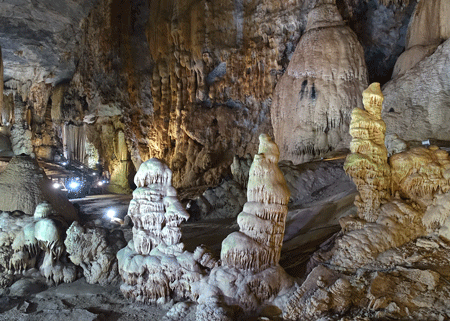
My Silly-Sand structures were very much like what we were seeing throughout the caves, only my structures were built in minutes versus the cave’s thirty to forty million year evolution.
Sooooo Big
It’s impossible to adequately describe the feeling of being in an enormous cave. We’d move through and under low cave ceilings, only to emerge into absolutely enormous open caverns that looked like a whole neighborhood would fit inside.
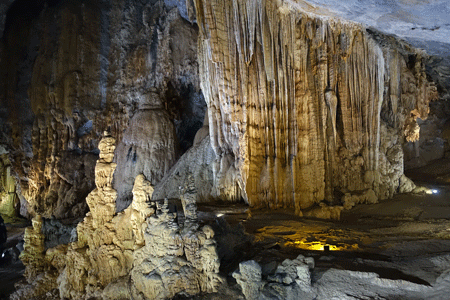
Kate said a 40 story building could fit in the largest cavern of the Paradise cave.
Most sections are immense and expansive, while others are small and intimate. And some sections look like you’re on another planet. It’s otherworldly.
The Chess Challenge
After a wonderful day exploring Phong Nha and Paradise caves, we had a delicious dinner back in Dong Hoi at The Treehugger Cafe. At the end of our meal, our waitress (who we think was German) came over and asked us for a favor. I assumed she was going to ask us to do a TripAdvisor review, like so many restaurants ask, but instead she pointed to a ten year old Vietnamese boy across the restaurant.
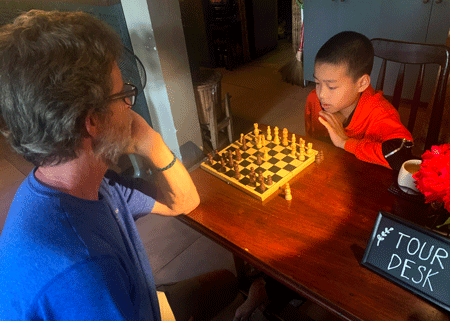
The boy was sitting in front of a chess board at the cafe’s tour desk. She explained that he’s a local boy who frequently comes to the cafe and plays chess with the staff, but today was different. Today he hoped to play against the bearded American. For anyone wondering, Steve did win the game, but admitted the boy was a worthy opponent.
I don’t know if the local people, like Steve’s young chess buddy, have the means or finances to visit the Phong Nha – Ke Bang National Park and the world renowned caves there, but I sure hope so.
Wins & Losses
Wins
Happening upon five men building a fairly large boat along the shore of the South China Sea. So skilled.
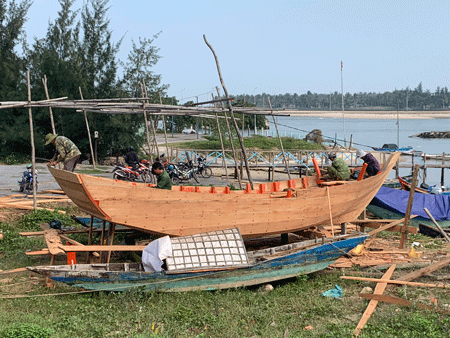
Watching the Nhật Lệ Bridge’s night lights change color from hot pink to red to blue and green.
Meeting Ken, the cute puppy owned by our hotel clerk. According to the hotel clerk, Vietnamese like to name their dogs American names. I have no idea why and neither did she. Common dog names in Vietnam are Ken, Eric, and Bailey.
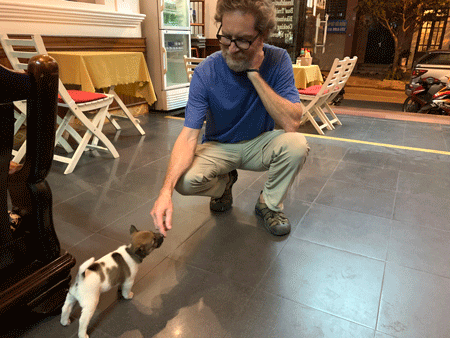
Losses
Walking a very long way to Nha Le beach only to discover the dozens of outdoor restaurants and beach facilities were closed for the “winter season”, with me really, really needing to use a bathroom. Note: It was 75 degrees, apparently Dong Hoi’s winter chill.
